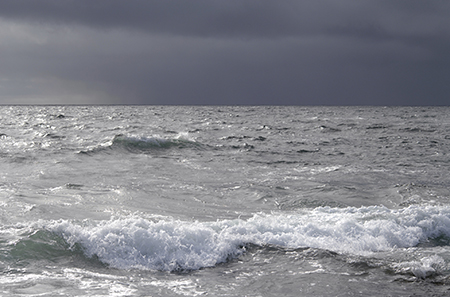 Professor Ric Williams: “Currents are strongly linked to our climate, the aim of the OSNAP array is to understand the connection between these variations and changes in ocean heat storage”
Professor Ric Williams: “Currents are strongly linked to our climate, the aim of the OSNAP array is to understand the connection between these variations and changes in ocean heat storage”
The University of Liverpool, as part of an international collaboration, has been awarded £20 million to monitor the North Atlantic ocean currents that shape Britain’s climate.
The `Overturning in the Subpolar North Atlantic Programme’ (OSNAP ), a five year project involving scientists from seven countries, will set up an array of moored instruments and use autonomous gliders across the North Atlantic, along a line running from Scotland to Canada via Greenland, to record ocean temperatures, salinity and the strength of currents in an area called the North Atlantic Subpolar Gyre.
Ocean conveyor belt
The team is interested in this region because the currents here, which are part of the so-called ocean conveyor belt, are known to be important for the Earth’s climate.
The conveyor belt is a system of ocean currents, which move heat around the world’s oceans. In the Atlantic Ocean, warm upper-ocean water travels north, to the high northern latitudes, where it loses heat to the atmosphere.
It is this process that keeps the UK weather relatively mild in winter compared to other countries at similar latitudes. This water cools then sinks and returns southwards at great depth.
Professor Ric Williams, from the School of Environmental Sciences, said, “Despite its name, the image of a conveyor belt is misleading, because the process isn’t smooth and continuous. Instead, the belt can stretch, rumple, fray or even stall. This means the strength of currents in the global conveyor belt can vary significantly.
“As these currents are strongly linked to our climate, the aim of the OSNAP array is to understand the connection between these variations and changes in ocean heat storage.”
 Scientists want to understand how the sub-polar gyre really works
Scientists want to understand how the sub-polar gyre really works
Funding for OSNAP has come from the Natural and Environmental Research Council (NERC), the US National Science Foundation (NSF) and the National Oceanic and Atmospheric Administration (NOAA).
Professor Williams added: “OSNAP is an exciting international scientific collaboration that will tackle critical gaps in our knowledge of how the high latitude oceans drive changes in the Atlantic Meridonal Overturning Circulation.
“The aim of monitoring the north Atlantic Subpolar Gyre will be to improve our understanding of how the ocean conveyor determine how heat is stored and released in the ocean, ultimately affecting our long-term climate and weather forecasts.”
Revolutionising climate research
Science Minister, David Willetts, who announced the project, said: “It is fitting that a project to better understand what affects the global climate, given the British fascination with weather conditions, has UK involvement.’
“Not only will this funding improve our understanding of the planet’s climate through innovative research, it will highlight the importance of one of the eight great technologies – autonomous and robotic equipment. The autonomous gliders being used for this project are helping to revolutionise climate research and are contributing to world class science.”
Dr Sheldon Bacon, from NERC’s National Oceanography Centre (NOC), said: “In the high latitudes of the North Atlantic, and the Arctic Ocean that it connects to, the ocean can efficiently imprint its memory on the atmosphere by releasing the huge amounts of heat stored in it. With average global temperatures currently rising by 0.75°C every hundred years, we need to be able to forecast how the climate might change before our descendants face the consequences.”
